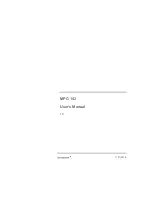
1.3
Page 15
MPC-
143. User’s Manual
o
"Modbus RTU Client". This mode working mode must be used when the
MPC-143 behaves as master in a Modbus RTU network (it sends Modbus
requests to the slaves connected to the Modbus RTU network). These
requests will be defined under the "Modbus devices" tab. Parameters to be
configured are:
o
"Enable": Do not enable any Modbus RTU client if not needed.
o
"UART": Select the UART to be associated to the Modbus RTU
client.
NOTE: Once a given UART is selected to be a Modbus RTU client,
it cannot be used with any other configuration such as COM client.
o
"Stack depth": number of requests that can be stacked in the UART
buffer. It is recommended to set this value to 1 by default.
o
“Timeout”: it defines the amount of milliseconds defined as time out.
o
"Number of repeats": number of retries defined in case of
transmission error.
o
"Delay before next request": In case peripheral devices need some
“extra time” to answer after a received request
NOTE: After configuration is completed, click on "
Set
" button in order to
save changes.
o
"Modbus RTU Server". This mode is used when the MPC-143 will be used
as Modbus slave in a network. Requests from a Modbus server will be
received and answered.
o
"Enable": Do not enable any Modbus RTU server if not needed.
o
"UART": Select the UART to be associated to the Modbus RTU
server.
NOTE: Once a given UART is selected to be a Modbus RTU
server, it cannot be used with any other configuration such as COM
client.
o
"Address": Define Modbus address for MPC-143. Modbus master
must send requests to the given address.
NOTE: After configuration is completed, click on "
Set
" button in order to
save changes.






























